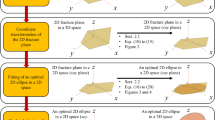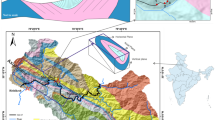Abstract
Distribution characteristics and strength of 3D discrete fractures have a decisive effect on the rock slope stability. How to use the fractures obtained on site to establish a 3D fractured rock slope for stability analysis is a difficult problem in the field of rock mass engineering. This study selected the rock slope on the right bank of Yigong Zangbu Bridge for a detailed field investigation. Exposed joints and fractures were measured and counted. Occurrence, size, and position distribution models of the fractures were used to obtain the parameters of the spatial distribution using probability and statistic theory. Then, a complex 3D discrete fracture network (DFN) was established and simplified. After that, a 3D rock slope model was built and the DFN was used to cut the slope model. Finally, the strength reduction method was used to analyze the slope stability. The results reveal that the overall slope stability is good (safety factor is 2.0), but the local block deformations are large and are mainly concentrated in the lower part of the slope. Due to the existence of structural planes dipping outside the slope on the right bank, local unstable blocks are easily formed. In this study, the whole process from field fracture acquisition to the DFN generation is applied to the 3D fracture rock slope stability analysis, which is of great importance for complex rock mass engineering assessment and disaster prevention.


















Similar content being viewed by others
References
Bao YD, Han XD, Chen JP, Zhan JW, Zhang W, Sun XH, Chen MH (2019) Numerical assessment of failure potential of a large mine waste dump in Panzhihua City, China. Eng Geol 253:171–183
Bao YD, Zhai SJ, Chen JP, Xu PH, Sun XH, Zhan JW, Zhang W, Zhou X (2020) The evolution of the Samaoding paleolandslide river blocking event at the upstream reaches of the Jinsha River Tibetan Plateau. Geomorphology 351:106970
Camones LAM, Vargas EDA, De Figueiredo RP, Velloso RQ (2013) Application of the discrete element method for modeling of rock crack propagation and coalescence in the step-path failure mechanism. Eng Geol 153:80–94
Chen JF, Liu JX, Xue JF, Shi ZM (2014) Stability analyses of a reinforced soil wall on soft soils using strength reduction method. Eng Geol 177:83–92
Chen JP, Xiao SF, Wang Q (1995) Three-dimensional network modeling of stochastic fractures. Northeast Normal University Press, Changchun
Chuan-Bin W, Shi B, Sun Y, Zhao YG (2004) Numerical simulation analyses on stability of the No.3 tunnel of Bainijing in Kunming by FLAC-3D. Hydrogeol Eng Geol 31(6):52–55
Cui SW, Tan Y, Lu Y (2020) Algorithm for generation of 3D polyhedrons for simulation of rock particles by DEM and its application to tunneling in boulder-soil matrix. Tunn Undergr Space Technol 106:103588
Cundall P, Strack O (1979) A discrete numerical model for granular assemblies. Geotechnique 29:47–65
Dershowitz WS, La Pointe PR, Doe TW (2004) Advances in discrete fracture network modeling. In: Proceedings of the US EPA/ NGWA fractured rock conference, Portland, ME, 882–894
Dowd PA, Xu C, Mardia KV, Fowell RJ (2007) A comparison of methods for the stochastic simulation of rock fractures. Math Geol 39:697–714
Drew JH, Glen AG, Leemis LM (2000) Computing the cumulative distribution function of the Kolmogorov-Smirnov statistic. Comput Stat Data An 34:1–15
Farah K, Ltifi M, Hassis H (2011) Reliability analysis of slope stability using stochastic finite element method. Procedia Eng 10:1402–1407
Guo Y (2015) Research on Evaluation Method of In-situ Stress in Southeastern Margin of Qinghai-Tibet Plateau. Master's thesis, Southwest Jiaotong University, Sichuan
Han XD, Chen JP, Wang Q, Li YY, Zhang W, Yu TW (2016) A 3D fracture network model for the undisturbed rock mass at the Songta dam site based on small samples. Rock Mech Rock Eng 49:611–619
Hatzor YH, Arzi AA, Zaslavsky Y, Shapira A (2004) Dynamic stability analysis of jointed rock slopes using the DDA method: King Herod’s Palace, Masada, Israel. Int J Rock Mech Min Sci 41(5):813–832
Ivanova VM, Sousa R, Murrihy B, Einstein HH (2014) Mathematical algorithm development and parametric studies with the GEOFRAC three-dimensional stochastic model of natural rock fracture systems. Comput Geosci 67:100–109
Johnson RA, Bhattacharyya GK (2009) Statistics: principles and methods, 6th edn. Wiley, Hoboken
Karzulovic A, Goodman RE (1985) Determination of principal joint frequencies. Int J Rock Mech Min Sci Geomech Abstr 22:471–473
Kemeny J, Post R (2003) Estimating three-dimensional rock discontinuity orientation from digital images of fracture traces. Comput Geosci 29:65–77
Kocharyan GG, Brigadin IV, Karyakin AG, Kulyukin AM, Ivanov EA (1995) Study of caving features for underground workings in a rock mass of block structure with dynamic action. Part IV. effect of rock mass structure on the stability of mine workings. J Min Sci 31:1–7
Kulatilake PHSW, Wathugala DN, Stephansson OVE (1993) Stochastic three-dimensional joint size, intensity and system modelling and a validation to an area in Stripa Mine, Sweden. Soils Found 33:55–70
Kulatilake PHSW, Wu TH (1984) Estimation of mean trace length of discontinuities. Rock Mech Rock Eng 17:215–232
Li XJ, Zuo YL, Zhuang XY, Zhu HH (2014) Estimation of fracture trace length distributions using probability weighted moments and L-moments. Eng Geol 168:69–85
Li YY, Wang Q, Chen JP, Han LL, Song SY (2014) Identification of structural domain boundaries at the Songta dam site based on nonparametric tests. Int J Rock Mech Min Sci 70:177–184
Lu Y, Tan Y, Li X (2018) Stability analyses on slopes of clay-rock mixtures using discrete element method. Eng Geol 244:116–124
Lu Y, Tan Y, Li X, Liu C (2017) Methodology for simulation of irregularly shaped gravel grains and its application to DEM modeling. J Comput Civ Eng 31(5):04017023
Lv Q, Liu Y, Yang Q (2017) Stability analysis of earthquake-induced rock slope based on back analysis of shear strength parameters of rock mass. Eng Geol 228:39–49
Marcotte D, Henry E (2002) Automatic joint set clustering using a mixture of bivariate normal distributions. Int J Rock Mech Min Sci 39:323–334
Mauldon M, Dunne WM, Rohrbaugh MB (2001) Circular scanlines and circular windows: new tools for characterizing the geometry of fracture traces. J Struct Geol 23:247–258
Meng QB, Han LJ, Xiao Y, Li H, Wen SY, Zhang J (2016) Numerical simulation study of the failure evolution process and failure mode of surrounding rock in deep soft rock roadways. Int J Min Sci Techno 26(2):209–221
Min KB, Jing L, Stephansson O (2004) Determining the equivalent permeability tensor for fractured rock masses using a stochastic REV approach: method and application to the field data from Sellafield, UK. Hydrogeol J 12:497–510
Munier R (2004) Statistical analysis of fracture data, adapted for modelling discrete fracture networks—version 2. Swedish Nuclear Fuel and Waste Management Company, Stockholm
Oda M (1982) Fabric tensor for discontinuous geological materials. Soils Found 22:96–108
Osada M, Shrestha SK, Kajiyama T (2005) Application of rock mass integration method (RMIM) with DDA modeling in rock slope stability. Contrib Rock Mech New Century 1–2:1257–1262
Regassa B, Xu N, Mei G (2018) An equivalent discontinuous modeling method of jointed rock masses for DEM simulation of mining-induced rock movements. Int J Rock Mech Mining Sci 108:1–14
Riley MS (2005) Fracture trace length and number distributions from fracture mapping. J Geophys Res-Sol Ea 110(B8):B08414
Seismic parameter zoning map of China (GB18306–2015) (2015) Published by the National Standardization Management Committee of China
Shi GH (1977) Stereoscopic projection method for rock stability analysis. Chin Sci 3:269–271 ((In Chinese))
Shi GH, Goodman RE (1988) Block Theory and Its Application to Rock Engineering. Eng Geol 26(1):103–105
Shi GH, Goodman RE (1982) A new concept for support of underground and surface excavation in discontinuous rocks based on a keystone principle. Int J Rock Mech Min Sci Geomech Abstr 19(3):50
Song JJ, Lee CI (2001) Estimation of joint length distribution using window sampling. Int J Rock Mech Min Sci 38:519–528
Tang CL, Hu JC, Lin ML, Angelier J, Lu CY, Chan YC, Chu HT (2009) The Tsaoling landslide triggered by the Chi-Chi earthquake, Taiwan: insights from a discrete element simulation. Eng Geol 106:1–19
Tonon F, Chen S (2007) Closed-form and numerical solutions for the probability distribution function of fracture diameters. Int J Rock Mech Min Sci 44:332–350
Wang G, Su L, Pang JR, Sun W (2015) Research on Precision of Partial Coefficient Finite Element Method in Stability Analysis for Rock Slope. Adv Mat Res 1089:248–252
Wang HB, Zhang B, Mei G, Xu NX (2020) A statistics-based discrete element modeling method coupled with the strength reduction method for the stability analysis of jointed rock slopes. Eng Geol 264:105247
Warburton PM (1980) A stereological interpretation of joint trace data. Int J Rock Mech Min Sci Geomech Abstr 17:181–190
Wei Z, Lü Q, Sun H, Shang Y (2019) Estimating the rainfall threshold of a deep-seated landslide by integrating models for predicting the groundwater level and stability analysis of the slope. Eng Geol 253:14–26
Xu CS, Dowd P (2010) A new computer code for discrete fracture network modelling. Comput Geosci 36:292–301
Xu LM, Chen JP, Wang Q, Zhou FJ (2013) Fuzzy C-means cluster analysis based on mutative scale chaos optimization algorithm for the grouping of discontinuity sets. Rock Mech Rock Eng 46:189–198
Ye YW (2019) Simplification of discrete fracture network and application in tunnel stability analysis. Master's thesis, China University of Geosciences, Beijing
Zhang L (1999) Analysis and design of drilled shafts in rock. PhD thesis, Massachusetts Institute of Technology, Cambridge, MA
Zhang L, Einstein HH (1998) Estimating the mean trace length of rock discontinuities. Rock Mech Rock Eng 31:217–235
Zhang L, Einstein HH (2000) Estimating the intensity of rock discontinuities. Int J Rock Mech Min Sci 37:819–837
Zhang Q, Wang Q, Chen JP, Li YY, Ruan YK (2016) Estimation of mean trace length by setting scanlines in rectangular sampling window. Int J Rock Mech Min Sci 84:74–79
Zhang W, Chen JP, Cao ZX, Wang RY (2013) Size effect of RQD and generalized representative volume elements: a case study on an underground excavation in Baihetan dam, Southwest China. Tunn Undergr Space Technol 35:89–98
Zhang W, Fu R, Tan C, Ma ZF, Zhang Y, Song SY, Xu PH, Wang SN, Zhao YP (2020) Two-dimensional discrepancies in fracture geometric factors and connectivity between field-collected and stochastically modeled DFNs: a case study of sluice foundation rock mass in Datengxia, China. Rock Mech Rock Eng 53:2399–2417
Zhang W, Lan ZG, Ma ZF, Tan C, Que JS, Wang FY, Cao C (2020) Determination of statistical discontinuity persistence for a rock mass characterized by non-persistent fractures. Int J Rock Mech Min Sci 126:104177
Zheng H, Liu DF, Li CG (2005) Slope stability analysis based on elasto-plastic finite element method. Int J Numer Methods Eng 64:1871–1888
Acknowledgements
This work was supported by the National Natural Science Foundation of China (Grant Nos. 41941017, U1702241) and the National Key Research and Development Plan (Grant No. 2018YFC1505301). The authors would like to thank the editor and anonymous reviewers for their comments and suggestions which helped a lot in making this paper better.
Author information
Authors and Affiliations
Corresponding author
Additional information
Publisher's Note
Springer Nature remains neutral with regard to jurisdictional claims in published maps and institutional affiliations.
Rights and permissions
About this article
Cite this article
Li, Y., Chen, J., Zhou, F. et al. Stability evaluation of rock slope based on discrete fracture network and discrete element model: a case study for the right bank of Yigong Zangbu Bridge. Acta Geotech. 17, 1423–1441 (2022). https://doi.org/10.1007/s11440-021-01369-5
Received:
Accepted:
Published:
Issue Date:
DOI: https://doi.org/10.1007/s11440-021-01369-5




